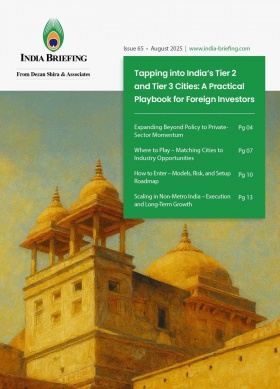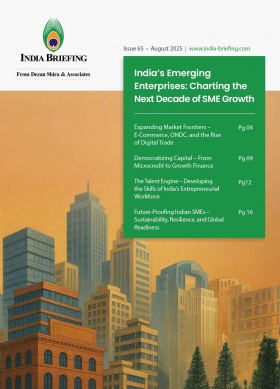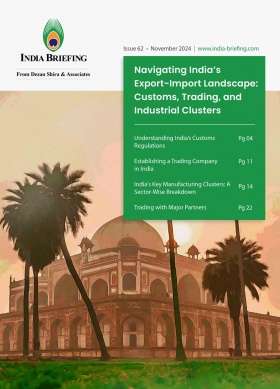India’s White Goods PLI Scheme Gets Extension Amid Rising Industry Interest
India initially opened the fourth round of applications under the Production Linked Incentive (PLI) Scheme for White Goods, covering LED products and air conditioners, for a 30-day period starting September 15, 2025. The application window has now been extended until November 10, 2025.
The round is open to both new applicants and existing beneficiaries looking to scale up investments, either by entering higher target segments or by applying through group companies across different product categories.
The Department for Promotion of Industry and Internal Trade (DPIIT) has extended the application window for round four of the PLI Scheme for White Goods, covering air conditioners and LED lights until November 10, 2025. The announcement was made on October 17, 2025.
Earlier in the year, the scheme was reopened for a 30-day period from September 15 to October 14, 2025. The latest extension follows increased industry participation and growing investment interest under the initiative.
As per an official statement issued on September 14, 2025, the launch of the fourth round of PLI applications reflects India’s objective to supporting manufacturing expansion in the white goods sector, driven by the positive outcomes of previous PLIWG rounds. Interested applicants can submit their proposals through the online PLIWG portal.
What are the incentives under the PLI scheme for white goods?
The PLI scheme provides incentives ranging from 4 percent to 6 percent on incremental sales to eligible manufacturers. It is valid from FY 2021-22 to FY 2028-29 and covers both high-value and low-value components of air conditioners and LED lights.
It must be noted that the opportunity is available to both new applicants and existing beneficiaries wishing to expand their investments, subject to scheme guidelines. Of the total allocated budget of INR 62.38 billion (US$707 million) for the scheme, India has released INR 2.87 billion (US$32.54 million) so far.
Background: Amendments to the scheme and previous rounds
After the initial rollout of the PLI Scheme in April 2021, additional application windows were opened under round 2 (March–April 2022) and round 3 (July–October 2024).
To make the scheme more industry-friendly, India also introduced four amendments in 2021, 2022, 2023, and 2024. These changes included adopting cost-plus pricing, widening the scope of eligible capital investments, and extending timelines.
Under round 4 (September-October 2025), the original guidelines (including all prior amendments) shall continue for the white goods PLI application process. For new applicants, the gestation period will be counted from April 2021 to March 2023, and they must meet the minimum cumulative investment threshold by FY 2025-26.
Companies that had applied earlier—with gestation periods ending in 2022 or 2023—will also have the option to upgrade to a higher investment category. However, in every case, incentives will be available only for the remaining duration of the scheme (till FY 2028-29).
Under the PLI scheme, the gestation period refers to the initial time frame given to a company to set up its manufacturing facilities and make the required investments before it starts claiming incentives.
During this period, companies are expected to establish new factories or expand existing ones, install plants & machinery, and subsequently begin commercial production.
Once this phase is over and the company meets the minimum cumulative investment and incremental sales thresholds, it becomes eligible to receive PLI benefits in the following years. In the case of the PLIWG, the gestation periods were fixed as mentioned below:
- GP-1: April 1, 2021 – March 31, 2022
- GP-2: April 1, 2021 – March 31, 2023
Conditions for moving to higher investment categories
Existing applicants who wish to scale up by shifting to a higher investment category must meet the revised minimum investment and sales thresholds set for that category.
If a company fails to achieve these targets in any given year, it may return to its original investment category. However, once this option is exercised, the company must remain in its original category. Any incentives already received under the higher category will need to be refunded with interest, calculated at SBI’s 3-year marginal cost of lending rate (MCLR) (compounded annually).
For applicants from rounds 1, 2, and 3, the revised minimum cumulative investment target will apply from FY 2025-26. Companies that upgraded during round 3 will continue to remain in their new category.
Target segments and products covered under PLIWG
PLIWG covers the manufacturing of key components and sub-assemblies used in white goods segments of ACs and LED lights. Both large-scale and medium-scale investments are eligible under the scheme. The scheme is open to companies engaged in manufacturing components and sub-assemblies, covering both greenfield projects (new manufacturing units) and brownfield projects (expansion of existing facilities).
Here is a comprehensive list of eligible products for the manufacturing of ACs and LEDs under PLIWG:
For ACs components, the product list is divided into two categories, i.e., high-value intermediaries of ACs and low-value intermediaries of ACs.
- High-value intermediaries of ACs: Compressors, including oil-free and high-capacity, copper tube (plain and/or grooved); and aluminum stock for foils or fins for heat exchangers.
-
Low-value intermediaries of ACs: Control assemblies for IDU or ODU or remotes, display panels (LCD/LED), motors, cross flow fan (CFF), valves and brass components, heat exchangers, sheet metal components and plastic moulding components
Similarly, for LED, the product list is divided into two categories namely, LED core components and LED light components.
- LED core components: LED chip packaging, integrated circuits (ICs), resistors, fuses, large-scale investments in LED components.
- LED light components: LED chips, LED drivers, LED engines, LED modules, Printed Circuit Boards (PCB), including metal-clad PCBs; mechanicals—housing, wire-wound inductors, drum cores, heat sinks, diffusers, ferrite cores, LED Light Management Systems (LMS), resistors, fuses, capacitors, LED transformers, laminates for PCB and metal-clad PCBs, metallized film capacitors
PLI white goods investment and sales thresholds
The eligibility criteria and incentive thresholds under the PLIWG cover both core and other components. They outline the annual PLI rates, minimum cumulative investments, and corresponding incremental sales targets that applicants must meet during the scheme period to qualify for incentives under the large and normal investment categories.
|
PLI Investment and Sales Thresholds for AC Components |
||||||||
|
|
|
|
Large investments (in INR million) |
Normal investments (in INR million) |
||||
|
Segment |
Year |
*PLI incentives on incremental sales |
Minimum cumulative incremental investment |
Minimum incremental sales |
Minimum PLI |
Minimum cumulative incremental investment |
Minimum incremental sales |
Minimum PLI |
|
ACs (components) |
2021-22 |
|
1500 |
– |
– |
5000 |
– |
– |
|
2022-23 |
6% |
3000 |
7500 |
– |
1000 |
2500 |
– |
|
|
2023-24 |
6% |
4000 |
15,000 |
450 |
1500 |
5000 |
150 |
|
|
2024-25 |
5% |
5000 |
20,000 |
900 |
2250 |
7500 |
300 |
|
|
2025-26 |
5% |
6000 |
25,000 |
1000 |
3000 |
11,250 |
380 |
|
|
2026-27 |
4% |
– |
30,000 |
1250 |
– |
15,000 |
560 |
|
|
2027-28 |
|
– |
– |
1200 |
– |
– |
600 |
|
|
Total |
|
6000 |
97,500 |
4800 |
3000 |
41,250 |
1,990 |
|
|
High-value intermediates |
2021-22 |
|
500 |
– |
– |
500 |
– |
– |
|
2022-23 |
6% |
1250 |
2500 |
– |
1000 |
2500 |
– |
|
|
2023-24 |
6% |
2000 |
6250 |
150 |
1500 |
5000 |
150 |
|
|
2024-25 |
5% |
3000 |
10,000 |
380 |
2000 |
7500 |
300 |
|
|
2025-26 |
5% |
4000 |
15,000 |
500 |
2500 |
10,000 |
380 |
|
|
2026-27 |
4% |
– |
20,000 |
750 |
– |
12,500 |
500 |
|
|
2027-28 |
|
– |
– |
800 |
– |
– |
500 |
|
|
Total |
|
4000 |
53,750 |
2580 |
2500 |
37,500 |
1830 |
|
|
Lower-value intermediates |
2021-22 |
|
200 |
– |
– |
100 |
– |
– |
|
2022-23 |
6% |
400 |
1000 |
– |
200 |
500 |
– |
|
|
2023-24 |
6% |
600 |
2000 |
60 |
300 |
1000 |
30 |
|
|
2024-25 |
5% |
800 |
3000 |
120 |
400 |
1500 |
60 |
|
|
2025-26 |
5% |
1000 |
4000 |
150 |
500 |
2000 |
80 |
|
|
2026-27 |
4% |
– |
5000 |
200 |
– |
2500 |
100 |
|
|
2027-28 |
|
– |
– |
200 |
– |
– |
100 |
|
|
Total |
|
1000 |
15,000 |
730 |
500 |
7500 |
370 |
|
|
PLI Investment and Sales Thresholds for LED Components |
||||||||
|
|
|
|
Large investments (in INR million) |
Normal investments (in INR million) |
||||
|
Segment |
Year |
*PLI incentives on incremental sales |
Minimum cumulative incremental investment |
Minimum incremental sales |
Minimum PLI |
Minimum cumulative incremental investment |
Minimum incremental sales |
Minimum PLI |
|
LED (core components) |
2021-22 |
|
1000 |
– |
– |
200 |
– |
– |
|
2022-23 |
6% |
1500 |
6000 |
– |
400 |
1200 |
– |
|
|
2023-24 |
6% |
2000 |
9000 |
360 |
600 |
2400 |
70 |
|
|
2024-25 |
5% |
2500 |
12,000 |
540 |
800 |
3600 |
140 |
|
|
2025-26 |
5% |
3000 |
15,000 |
600 |
1000 |
4800 |
180 |
|
|
2026-27 |
4% |
– |
18,000 |
750 |
– |
6000 |
240 |
|
|
2027-28 |
|
– |
– |
720 |
– |
– |
240 |
|
|
Total |
|
3000 |
60,000 |
2970 |
1000 |
18,000 |
880 |
|
|
Components of LED lights |
2021-22 |
|
50 |
– |
– |
20 |
– |
– |
|
2022-23 |
6% |
100 |
300 |
– |
40 |
120 |
– |
|
|
2023-24 |
6% |
150 |
600 |
20 |
60 |
240 |
10 |
|
|
2024-25 |
5% |
200 |
900 |
40 |
80 |
360 |
10 |
|
|
2025-26 |
5% |
250 |
1200 |
50 |
100 |
480 |
20 |
|
|
2026-27 |
4% |
– |
1500 |
60 |
– |
600 |
20 |
|
|
2027-28 |
|
– |
– |
60 |
– |
– |
20 |
|
|
Total |
|
250 |
4500 |
220 |
100 |
1800 |
90 |
|
Source: PLI White Goods Manufacturers in India, DPIIT.
*Actual disbursement of PLI for a respective year will be subsequent to that year. For example, subject to fulfilling the conditions of cumulative threshold incremental investment up to FY 2021-22 over base year and threshold incremental sales of manufactured goods over the base year in FY 2022-23, PLI will be disbursed in FY 2023-24.
Business advisory for foreign investors: Leveraging India’s PLI Scheme for white goods
The reopening and extension of the PLIWG application window in 2025 underscores India’s aim to boost local manufacturing and reduce import dependence. New applicants should note that the scheme’s gestation period—meant for setting up facilities, installing equipment, and starting production—ends in FY 2025–26. With incentives available only until FY 2028–29, timely planning and adherence to compliance are crucial for manufacturers and investors.
India offers strategic advantages beyond PLI incentives, including 100 percent foreign direct investment (FDI) in consumer durables through the automatic route, competitive labor costs, expanding infrastructure, and strong domestic demand. Coupled with trade agreements such as the Regional Comprehensive Economic Partnership (RCEP), these factors position India as a hub for electronics and consumer durables manufacturing, with opportunities to build export-oriented operations.
Foreign firms should assess eligibility based on product portfolios, align capital expenditure to meet scheme thresholds, and select locations strategically. Key hubs include Noida (electronics), Pune (large-scale manufacturing), and southern states like Tamil Nadu and Karnataka for industrial parks and supply chains. However, navigating India’s tax, labor, and regulatory frameworks remains complex.
Engaging local professional services firms can help investors structure their entry, maximize available fiscal incentives, and ensure smooth operations while remaining compliant with scheme conditions.
Industry participation and investment commitments under PLIWG
As of 2025, India has approved 83 applicants under the scheme with committed investments totaling INR 104.06 billion (US$1.18 billion). Major electronics and consumer durables players such as Daikin, Voltas, and Hindalco are investing in the manufacturing of air conditioner components, while firms including Dixon, R.K. Lighting, and Signify are focusing on LED light components.
In round three of applications, the central government received 38 proposals, of which 18 new companies—10 in the air conditioner segment and 8 in the LED light segment—received provisional approval, adding INR 22.99 billion (US$260.7 million) in investment. On January 20, 2025, the Union Ministry of Commerce and Industry announced that six existing beneficiaries have opted to move into higher investment categories, committing an additional INR 12.17 billion (US$138 million).
These developments are expected to boost India’s domestic manufacturing base, reduce reliance on imports, and improve global competitiveness. Reopening of the PLI Scheme for White Goods presents a timely opportunity for foreign manufacturers and sourcing companies to establish or expand their presence in India’s fast-growing consumer durables market.
(US$1 = INR 88.18)
(This article was originally published on September 15, 2025. It was updated on October 21, 2025.)
About Us
India Briefing is one of five regional publications under the Asia Briefing brand. It is supported by Dezan Shira & Associates, a pan-Asia, multi-disciplinary professional services firm that assists foreign investors throughout Asia, including through offices in Delhi, Mumbai, and Bengaluru in India. Dezan Shira & Associates also maintains offices or has alliance partners assisting foreign investors in China, Hong Kong SAR, Vietnam, Indonesia, Singapore, Malaysia, Mongolia, Dubai (UAE), Japan, South Korea, Nepal, The Philippines, Sri Lanka, Thailand, Italy, Germany, Bangladesh, Australia, United States, and United Kingdom and Ireland.
For a complimentary subscription to India Briefing’s content products, please click here. For support with establishing a business in India or for assistance in analyzing and entering markets, please contact the firm at india@dezshira.com or visit our website at www.dezshira.com.
- Previous Article Depreciation Rules and Asset Management under Indian GAAP: An Explainer
- Next Article India Climate Risk Advisory: Localizing Your Business Continuity Plans








